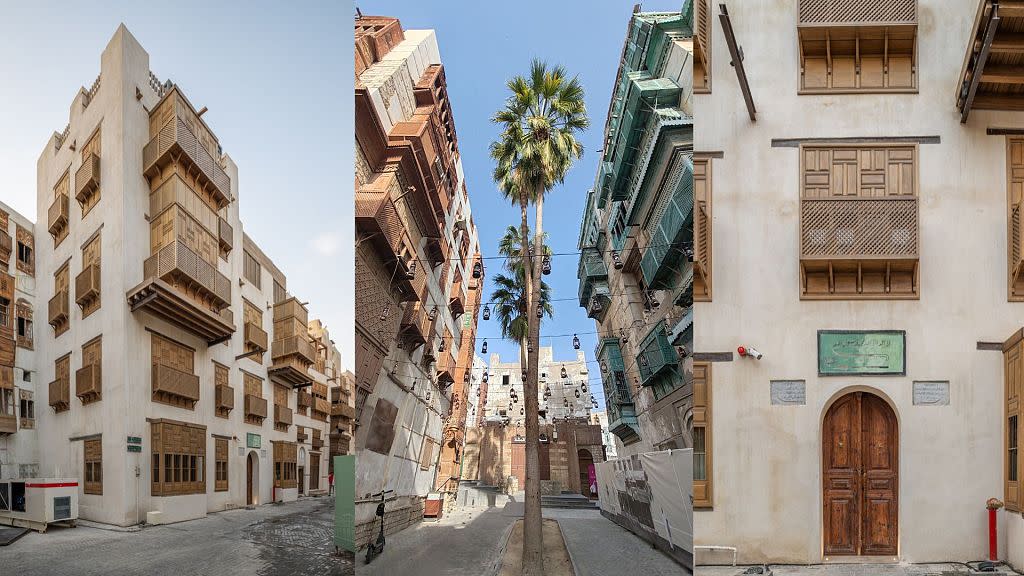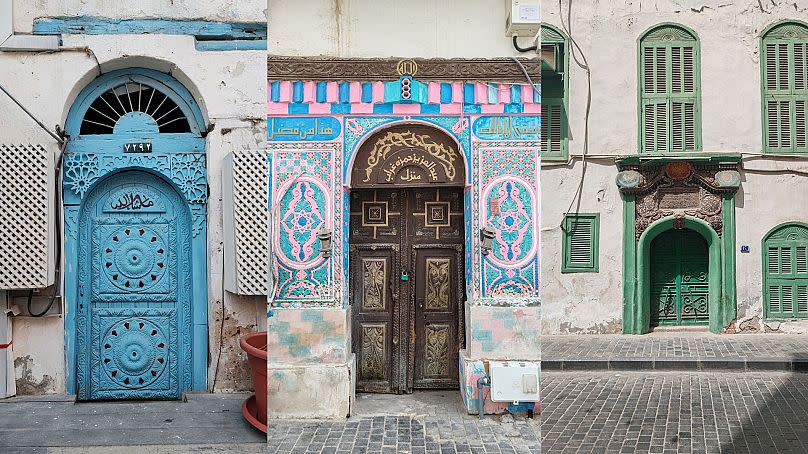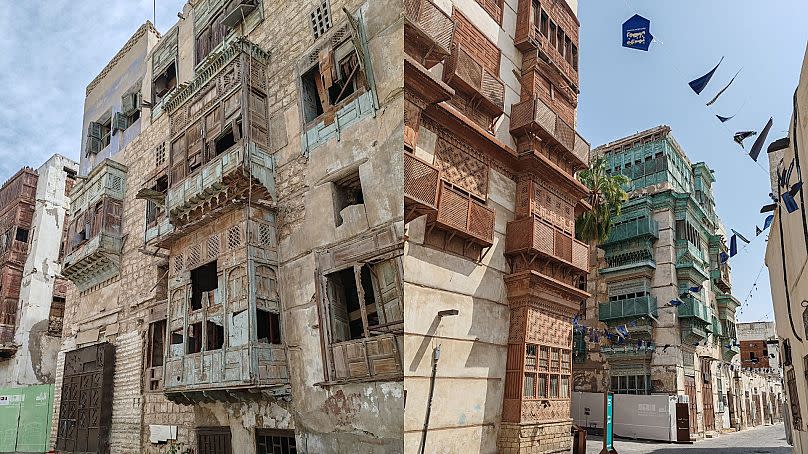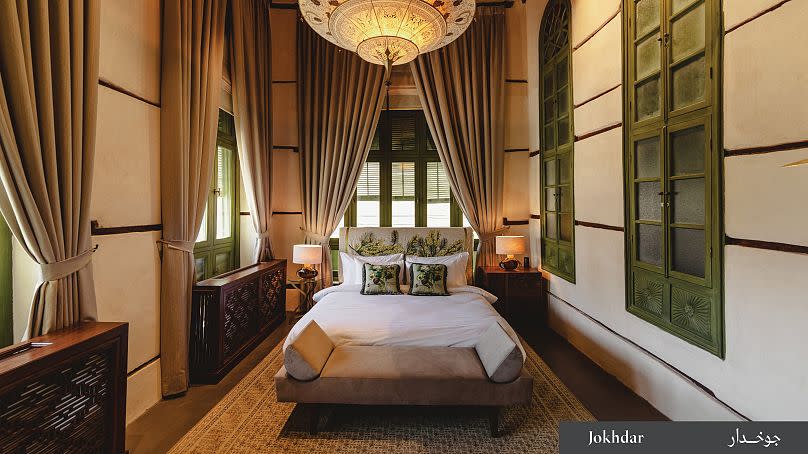Boutique hotels and buzzing souqs: Discover the historic heart of Jeddah

In the airy, high-ceilinged dining room of Beit Johkdar Hotel, Jeddah, breakfast is being served. It begins with a basket of warm bread - sesame seed encrusted, cardamon infused and traditional flatbread - with herby butter and black honey.
Next come the entreés, spicy olive tapenade, grilled halloumi with apricot jam, fried vegetables and a mini loaf of feta-marbled bread. This is followed by homemade falafel with tahini dipping sauce, spiced hummus, foul mudammas beans and shakshuka.
By the time the tiny pancakes, banana bread and fresh fruit arrive, I’ve long admitted defeat. I soon learn the exquisitely presented dishes, deferential waiting staff and sheer volume of food are typical of Saudi hospitality.
Beit Johkdar is one of three historic hotels that have just opened in Jeddah, a city on the Red Sea coast. Several more properties in Al Balad - the old town - are due to open in the next few years. All are part of the Jeddah regeneration project and the wider, ambitious Saudi vision for tourism.
As a country that only began offering tourist visas in 2019, it is a bit of a wild card for a holiday - all the more so if you visit during Ramadan, as I did. Here’s how the country is undergoing dramatic change as it opens up to tourism and how you can dive into its artisanal culture, belt-busting cuisine and storied hospitality in Jeddah.
Jeddah: An ancient city undergoing a renaissance
Driving from the airport into the heart of Jeddah city, you pass kilometre after kilometre of residential blocks, flashy stores and illuminated shopping arcades. But the historic centre - known as Al Balad - is what is drawing tourists.
The name of this ancient city derives from the word grandmother, referring to Eve who descended to earth right on the spot where the city now stands, as Abeer Abu Suleiman, Saudi Arabia’s first female tour guide, explains.
As early as the 1st century BCE, Jeddah was already a thriving fishing hub and a prominent stop on trading routes. It also flourished thanks to its role as the gateway to Mecca, welcoming religious pilgrims from across the globe on their Hajj journeys.

Al Balad has remained the historic heart of this city but, by the late 20th century, its antiquated homes were being abandoned by families seeking more modern and well-equipped houses in newer neighbourhoods.
The area’s fortunes began to change with its UNESCO designation in 2014. In 2021, a regeneration masterplan was announced - and royally endorsed - and the Jeddah Historic District programme was launched to restore some 600 historic properties for residential, tourism and business purposes.
The buildings are constructed from coral stone, limestone and wood. Some are many centuries old and painstaking work has gone into researching and passing on the knowledge of local materials and craftsmanship.
The houses of Al Balad are famous for their roshan - wooden box balconies covering windows intricately decorated with latticework designs and painted in Tunisian blue and Saudi green. These multifunctional structures allow a breeze into rooms, block sunlight and once provided a private space where women could look out without being observed.

Beyond the buildings, the project aims to regenerate the spirit and vitality of a community. In the squares, there are wooden benches and games for children. Museums like the Tariq Abdulhakim Music Center, named after a renowned Saudi musician, have opened. In a labyrinth of narrow alleys, the collective Zawiya 97 has provided workshop space for artisans producing contemporary products using traditional techniques.
Reem Abdulghani demonstrates her own 3D embroidery technique and her clothing label makes a statement with the use of fuchsia and yellow instead of the ubiquitous black and beige of women’s outfits. At woodturning workshop ‘Aromat’, 29-year-old Hassan Mohammed sells artisanal hand-crafted bowls, vases, and candlesticks.
Boutique hotels in historic homes: Where to stay in Jeddah
By the end of the project, 34 structures in Al Balad will house boutique hotels. Three are already operating - Beit Jokhdar, Beit Al Rayess and Beit Kedwan - all within walking distance of each other.
The concept behind the properties is much more than just a place to sleep. The historic residences are named after their previous owners and recreate the personal, individualised experience akin to being a house guest. Their descendants shared memories to help with the restoration.
On arrival, I am shown to the ‘lobby’ in Beit Johkdar, the grandest of the three properties and a kind of central hub at the moment. The entrance hall with its high wooden beamed ceiling, pale stone flags and Arabic inscriptions in gypsum is lit by a chandelier.

I'm poured Arabic coffee - ochre-coloured and infused with cardamom - from a sleek gold-coloured pot while Arabic music tinkles softly. I relax on a plush velvet sofa as the receptionist does the paperwork somewhere out of sight.
At Beit Al Rayess, the architecture is more intimate, with lower ceilings and archways graced with giant ceramic vases. I have a sequence of little rooms - entranceway, bathroom, living area, dressing area and bedroom. The furnishings are dark wood, cream upholstery and plenty of plants.
Beit Kedwan can only be rented in its entirety and has two bedrooms. The lavish residence has a living room with Moorish arched niches and mother-of-pearl inlaid tables and a roof terrace with cushioned seating, lanterns and a canopy. The grand main bedroom has two large artistically-faded rugs and a Murano-style chandelier.
What is it like to visit Jeddah during Ramadan?
Travellers may consider it unwise to visit during Ramadan season; it certainly poses challenges like the lack of food outlets open during the day. But if you can be flexible with your itinerary and sleep schedule, the Muslim festive period is joyous to experience.
Aside from brief two to three-hour windows, shops, restaurants and cafes are closed until late afternoon or evening. But the dearth of crowds during the day does present an opportunity to take a tour on a golf cart unimpeded and snap some atmospheric photos.
Saudi Arabia is building a futuristic ski resort in the middle of the desert
Discover Riyadh: Why now is the time to visit Saudi Arabia’s futuristic capital
The reason to visit during Ramadan becomes clear around 6pm, when queues form in front of streetside kiosks serving freshly prepared traditional foods - strips of beef liver, khubz bread, samosas, a banana and date bake and a fermented yoghurt drink called sobia.
People from all around Jeddah and further afield pile into Al Balad in the evening for iftar - the breaking of the fast. Families, groups of friends and couples gather at tables set out in the squares beneath trees bedecked with fairy lights. They unpack their kiosk food from bags and open takeaway boxes in preparation for sunset.
The atmosphere is quiet and reflective. The muezzin begins his undulating call that resonates around the piazzas and signals that it’s time to break the fast. It is a spiritual and devotional moment but one of community and warmth.
As evening fades to night, people crowd the streets in their finery; abayas are encrusted with gold beads, pearls and embroidery.
There are dozens of ushers with Ramadan-tagged vests to direct the foot traffic and hype up the crowd with celebratory shouts. There's also an army of street cleaners who seem to appear at your elbow miraculously the moment you have empty containers.
Untouched waters: The Saudi Arabian destination promising scuba fans unparalleled diving
Diriyah: Inside the €57 billion ‘giga-project’ set to transform the birthplace of Saudi Arabia
At perfume shops, staff stand outside with chalices of burning incense wafting their smoky fragrance over passersby in a traditional welcome.
With Abeer, I while away the hours peeking into 300-year-old buildings with rooftop stargazing and museums with tasters of Ramadan sweets. We dip into tiny shops in the city’s five souqs where abayas bulge from racks along the walls; and learn about the Mecca pilgrimage at the 600-year-old Al Shafei mosque.
I retire to bed at 1am, but the Jeddawi stay out much longer.

